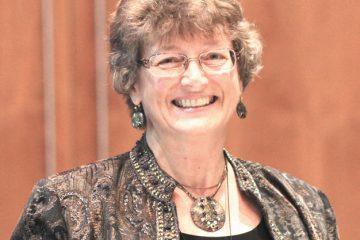Chief expectations

Myths and Misconceptions Series
The Jewish Family Identity Forum with Candace R. Kwiatek, The Dayton Jewish Observer
As an emergency room physician, my husband has many opportunities to mentor medical students and residents. To practice good ER medicine, he counsels that it’s not enough to establish the symptoms, examine the patient, and diagnose and treat the problem.
Good medical outcomes and patient satisfaction require three additional elements: establishing a personal connection with the patient, inviting patient involvement in their treatment plan, and eliciting and addressing the patient’s chief expectation, even if you can’t fulfill it.
I wonder: how might these key elements apply to synagogues? Personal connections and member involvement are hallmarks of synagogue life, but what about congregants’ chief expectations?
Community
As a member, I expect the support and camaraderie of the synagogue community.
Synagogues must be welcoming and foster relationships just as they establish support systems for challenging times such as death or disaster.
But a synagogue isn’t just a service provider; community isn’t a one-way street. It is the product of sharing, engagement, and face time on the part of the congregants.
The more you show up and get involved, the more you create the community you seek.
A good friend recently shared that he joined his synagogue for its friendliness, but only got involved when he started attending weekly to say the Mourner’s Kaddish.
Midway through the year, he realized he was attending more for the friendships than for the Kaddish. As the synagogue reached out to invite further participation, he became more involved.
Today he’s an active service leader, program attendee, and president of the board.
Synagogues can go a long way in meeting the chief expectation of community, but it’s a two-way street that ultimately depends on individual involvement.
Spirituality
I want spirituality from my synagogue. All human beings are inherently spiritual, having been created in the image of God with a soul from God’s breath (Gen. 2:7). According to Prof. Neil Greenberg in Can Spirituality be Defined?, spirituality has three components: emotion (feelings of awe, consolation); cognition (values and beliefs about oneself, the world, the meaning of existence); and practice (music, meditation, ceremony).
Certainly the synagogue, through its architecture, rituals, foods, teaching, and music, can offer many tools to arouse or tap into your inner essence.
But it cannot give spirituality, an innately personal process. That being said, synagogues should broaden their offerings to include a variety of service settings, multiple approaches to exploring values and teachings of Jewish tradition, and expanded music repertoires to encourage and facilitate those personal journeys and to address the expectation of discovering spirituality.
Learning
I want Jewish education — not Jewish indoctrination — that also has practical application. From the biblical Abraham to the great rabbis of the Talmud to Abraham Joshua Heschel, Judaism has encouraged learning, exploring, debating, and challenging.
Today’s Jews of all ages want to return to that model, to explore controversial issues like belief in God, the purpose of existence, the meaning of goodness, and other difficult topics.
Jews also seek practical guidance about what it means to live as a Jew in a secular world. Synagogues have the resources to facilitate such engagement, but to meet their members’ expectations they will have to rethink the traditional lecture and Bible study classes and look outside the box for new approaches.
At the same time, congregants will need to both request and then participate in such learning opportunities.
Prayer
I need meaningful prayer that works. My high school students recently questioned the purpose of prayer if it doesn’t result in God’s intercession.
This perception of God as a celestial butler suggests a need for all ages to explore the aims, meanings, and intended experiences of Jewish prayer.
Incidentally, the students were fascinated to learn that the Hebrew word for pray, l’hitpaleyl, means to examine or judge oneself.
Prayer workshops could involve creative writing, drama, storytelling, and more, but regular engagement with prayer is necessary for personally meeting this expectation.
Engagement
I need something purposeful and relevant to do. Most people want to be part of something bigger than themselves, to be inspired.
Some find this in synagogue leadership or learning. Others become engaged when working at synagogue-sponsored food pantries and shelters, tutoring programs, interfaith programs, supply collection events for refugees, and other worthwhile projects. While no one program fits all, this is a chief expectation that can be easily met by matching congregants’ interests with community needs.
Comfort
I want to feel comfortable. The physical comfort of cushioned chairs and a good sound system. The spiritual comfort of being surrounded by traditions from your childhood. The emotional comfort of being with people who share your values and aspirations or a non-judgmental atmosphere.
Synagogues should be aware of these comfort expectations and find ways to address even the conflicting or unrealistic ones while also pointing out that “come as you are, leave as you are” is not a synagogue aspiration.
Just like medical patients, congregants and the unaffiliated often expect synagogues to provide everything they want with little or no personal investment.
But Judaism isn’t a one-way street or a sideline spectator sport, and synagogues have the potential to offer a great deal to the community.
Perhaps we ought to stop pointing fingers and start holding out our hands to begin meeting our expectations.
Family Discussion: One way the physician can elicit chief expectations in the emergency room is to ask, “What were you hoping that we would accomplish today?” Not “What can I and the hospital community do for you?” but “What can you and I together accomplish?” Keeping that in mind, what are your chief expectations of your synagogue and how are you playing a role in the response?
Literature to share
The Patchwork Torah by Allison Ofanansky — A multi-generational family of sofers (Jewish scribes) rescues four Torah scrolls that are patched together into an old-new scroll. Crafted for the early elementary set, this thoughtful and heartwarming tale is a perfect Simchat Torah family read.
Eating the Bible by Rena Rossner — Originally appearing in serial form in the Jerusalem Post, the recipes and commentaries in this fascinating volume bring the Torah to the table. Following the order of the Five Books, each of the easy recipes and its accompanying facts, historical notes, and thought-provoking questions is a clever culinary trigger for a discussion of the weekly Torah portion.
To read the complete October 2014 Dayton Jewish Observer, click here.



